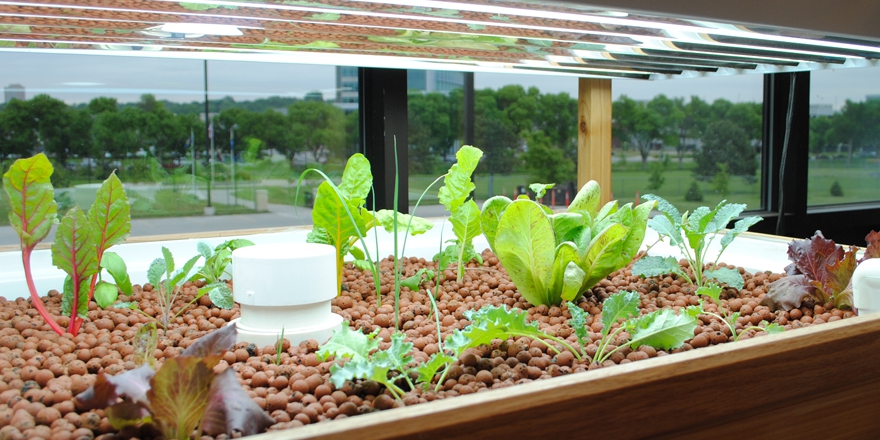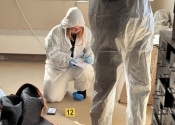
New aquaponics system in Hill-Macaluso Hall illustrates STEM concepts for CSM students
Out of sight, but not out of mind.
The ‘magic’ of an aquaponics system isn’t just in the fish swimming in a tank. It’s not just in the lush plants thriving beneath the grow lights. It’s also in what you can’t see. It’s also in the bacteria that live, invisible to the naked eye, in the terra cotta-colored growing medium.
In the new, 100-gallon aquaponic system in Hill-Macaluso Hall, the synergy of plants, fish and bacteria are exposing CSM students to STEM concepts, like nutrient cycling, that can be difficult to grasp using traditional teaching methods.
In aquaponics, fish and plants are raised together in a closed-loop, natural, recirculating system. The fish are raised in a tank, which is attached to a grow bed for the plants. The water in which the fish are raised is periodically flooded through the growing medium which supports both the plants and the critical bacteria.
Here’s where the unseen magic of chemistry takes place.
“The fish excrete ammonia through their gills into the water as a natural part of their metabolism,” says CSM biology instructor Mike Kaminski. Some forms of ammonia are toxic to fish, but bacteria in the system not only renders it safer for the fish, it also converts it into the type of nitrogen preferred by plants. Students can monitor that process through chemical analysis of the water.
“You can’t see them,” says Kaminski, “but water chemistry tests show what bacteria are doing by revealing the amount of each form of nitrogen present.”
Aquaponics can illustrate concepts in other STEM areas, as well. For example, the bell siphon, which regulates the ebb and flow of water from the fish tank to the grow bed, demonstrates the Venturi effect of physics (the reduction in fluid pressure that results when a fluid flows through a constricted section of a pipe).
Aquaponics “will also enhance our ability to teach biology concepts in an active and engaging way,” says Arts, Sciences & Professional Studies Division Chair Dr. Jeff Keyte. “It will contribute to our ability to offer academic excellence and foster leadership in students taking biology classes.”
High School Leadership Academy students, student workers, and Bio 269 Environmental Lab students will be exposed to concepts in biology, chemistry and physics through observation and hands-on participation with the larger system. Environmental lab students receive even more in-depth exposure. As part of their lab grade, these students will construct and care for a smaller desktop aquaponics system during the semester. They will build it, monitor water chemistry, and select and maintain their own plants and fish.
The new aquaponics tank will provide opportunities for not only CSM students, but others, as well. Omaha-area elementary, middle and high school students will be able to learn about aquaponics and sustainable water systems, as well as other subjects during summer academies and special academic programs.
The new aquaponic system was made possible through the generosity of donor Barbie Hayes.











